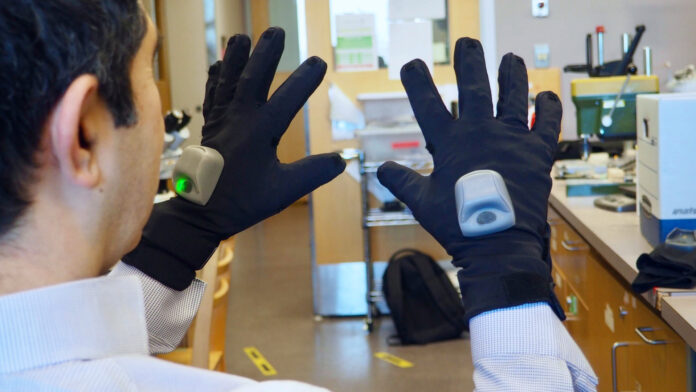This wearable sensor was made to fit like a glove. And thanks to a specially designed smart textile, it is set to help stroke patients recover mobility and control of their hands in a new way.
Peyman Servati, professor of electrical and computer engineering at the University of British Columbia, led the design of a comfortable and stretchy glove that can track hand and finger movement in 3D space by weaving in a network of wireless sensor yarns. Added pressure sensors also enabled the team to measure the force used to grasp objects. The study was published in Nature Machine Intelligence.
Capturing enough information about hand movements to get a full picture is challenging because the hand includes so many joints and ways that each part can move through space. Even motion capture video struggles with this complex task because the view of parts of the hand can be blocked, especially if the hand is interacting with an object, as they often are during rehab.
The sensors in the new smart gloves track and wirelessly transmit data on hand movements and pressure for analysis in real time, providing detailed information that can help a patient’s rehab team give immediate feedback.
Servati partnered with stroke rehabilitation specialist Janice Eng, professor of medicine at UBC, to use the gloves to study the hand movements of stroke survivors during rehab exercises.
“With this glove, we can monitor patients’ hand and finger movements without the need for cameras. We can then analyze and fine-tune their exercise programs for the best possible results, even remotely,” said Eng in a press release.
“This is the most accurate glove we know of that can track hand and finger movement and grasping force without requiring motion-capture cameras,” added Servati.
“Thanks to machine learning models we developed, the glove can accurately determine the angles of all finger joints and the wrist as they move. The technology is highly precise and fast, capable of detecting small stretches and pressures and predicting movement with at least 99 percent accuracy — matching the performance of costly motion-capture cameras.”
The analysis has even revealed patterns for how other parts of the arm and hand work to compensate for weaknesses or limited range of motion during specific movements.
Beyond stroke rehabilitation, the same technology would easily translate into other medical conditions where tracking hand movements would be a benefit. It could also extend into telehealth applications for rural areas or even health tracking during space exploration. Being able to track gestures so quickly and with such precision could also lead to advances in how we control robotics remotely, or even automate sign language interpretation in real time.
Through start up company Texavie, the team is already working on manufacturing the gloves in hopes of bringing them to the consumer market.








































